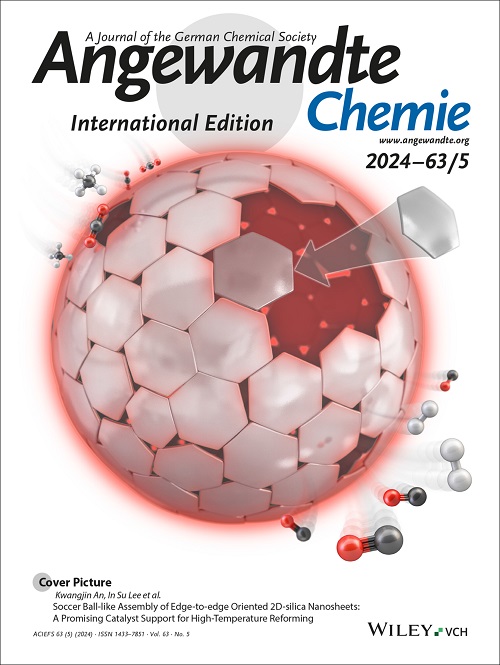Efficient Hydrogen Sulfide Separation from Carbon Dioxide Achieved by Carbonyl-Functionalized Ionic Liquids for Natural Gas Upgrading.
IF 16.9
1区 化学
Q1 CHEMISTRY, MULTIDISCIPLINARY
引用次数: 0
Abstract
Natural gas upgrading requires efficient separation of H2S from CO2, another acidic impurity, to enhance gas utilization efficiency and enable resource recovery from waste streams. While significant advancements have been achieved in separating H2S from CH4, the selective removal of H2S from CO2 remains a formidable challenge due to their similar physicochemical properties. Herein, we report a breakthrough strategy utilizing reversible nucleophilic addition reaction between carbonyl group and H2S, departing from conventional acid-base interaction-based liquid-phase capture processes. Through comprehensive characterization using nuclear magnetic resonance (NMR) and Fourier transform infrared (FT-IR) spectroscopy, we confirmed the formation of nucleophilic addition products between the designed carbonyl-functionalized ionic liquids (ILs) and H2S. Dispersion-corrected DFT calculations revealed that the nucleophilic addition products facilitate secondary H2S capture through two distinct approaches: 1) conformational matching and 2) dissociation of H2S into [HS]⁻ species. The unique cascade H2S sorption mechanism demonstrates exceptional affinity for H2S, endowing the [6ca]-derived ILs with unprecedented high H2S capacities and record-breaking H2S/CO2 selectivities (67-89 at 1.0 bar and 229-319 at 0.1 bar), surpassing previously reported values. Combined with energy-efficient regeneration cycles, these findings establish a new paradigm for H2S/CO2 separation with significant potential for natural gas valorization.羰基功能化离子液体在天然气改造中的高效硫化氢分离
天然气改造需要将H2S与另一种酸性杂质CO2有效分离,以提高天然气利用效率,并从废液中回收资源。虽然在分离H2S和CH4方面已经取得了重大进展,但由于其相似的物理化学性质,从CO2中选择性去除H2S仍然是一个艰巨的挑战。在此,我们报告了一种突破性的策略,利用羰基和H2S之间的可逆亲核加成反应,而不是传统的基于酸碱相互作用的液相捕获过程。通过核磁共振(NMR)和傅里叶变换红外(FT-IR)光谱的综合表征,我们证实了所设计的羰基功能化离子液体(ILs)与H2S之间形成亲核加成产物。经色散校正的DFT计算表明,亲核加成产物通过两种不同的方式促进H2S的二次捕获:1)构象匹配和2)H2S解离成[HS]毒枭。独特的级联H2S吸附机制显示了对H2S的特殊亲和力,使[6ca]衍生的ILs具有前所未有的高H2S容量和破纪录的H2S/CO2选择性(1.0 bar时67-89,0.1 bar时229-319),超过了之前报道的值。结合节能再生循环,这些发现为H2S/CO2分离建立了新的范例,具有巨大的天然气增值潜力。
本文章由计算机程序翻译,如有差异,请以英文原文为准。
求助全文
约1分钟内获得全文
求助全文
来源期刊
CiteScore
26.60
自引率
6.60%
发文量
3549
审稿时长
1.5 months
期刊介绍:
Angewandte Chemie, a journal of the German Chemical Society (GDCh), maintains a leading position among scholarly journals in general chemistry with an impressive Impact Factor of 16.6 (2022 Journal Citation Reports, Clarivate, 2023). Published weekly in a reader-friendly format, it features new articles almost every day. Established in 1887, Angewandte Chemie is a prominent chemistry journal, offering a dynamic blend of Review-type articles, Highlights, Communications, and Research Articles on a weekly basis, making it unique in the field.

 求助内容:
求助内容: 应助结果提醒方式:
应助结果提醒方式:


